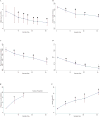Toward a definition of "fresh" whole blood: an in vitro characterization of coagulation properties in refrigerated whole blood for transfusion
- PMID: 20663116
- PMCID: PMC3821701
- DOI: 10.1111/j.1537-2995.2010.02772.x
Toward a definition of "fresh" whole blood: an in vitro characterization of coagulation properties in refrigerated whole blood for transfusion
Abstract
Background: The hemostatic property of "fresh" whole blood (WB) has been observed in military application and cardiac surgery and is associated with reduced blood loss, transfusion requirements, and donor exposures. The time from donation to transfusion defining "fresh" has not been systematically studied. We undertook an in vitro study of coagulation properties of refrigerated WB stored for 31 days.
Study design and methods: Twenty-one WB units were obtained from healthy volunteer donors and stored under standard AABB refrigerated conditions. Samples were obtained on the day after donation and again on Days 2, 4, 7, 11, 14, 17, 21, 24, and 31. Tests included complete blood count, pH, pO2, pCO2, glucose, lactate, thromboelastography (TEG), and platelet function by light transmission aggregometry (LTA).
Results: There was progressive decline in pH, pO2, glucose, and sodium, but progressive increase in potassium, pCO2, and lactate. TEG variables in all units were normal through Day 11; abnormal values in some variables in some units began on Day 14. Final aggregation levels exhibited no change from Day 1 to Day 21 with adenosine diphosphate and epinephrine, but a decline with collagen (Day 7) and ristocetin (Day 17).
Conclusion: This in vitro study of coagulation properties demonstrates preservation of normal integrated coagulation function to a minimum of 11 days under standard conditions of refrigerated storage of WB for transfusion. These observations strongly suggest that the hemostatic quality of WB may extend beyond current transfusion practices. If confirmed clinically, this would increase availability and extend benefits of reduced donor exposure and transfusion requirements.
© 2010 American Association of Blood Banks.
Conflict of interest statement
Figures





Comment in
-
Fresh thinking about fresh whole blood.Transfusion. 2011 Jan;51(1):5-7. doi: 10.1111/j.1537-2995.2010.02854.x. Transfusion. 2011. PMID: 21219320 No abstract available.
Similar articles
-
Primary hemostatic capacity of whole blood: a comprehensive analysis of pathogen reduction and refrigeration effects over time.Transfusion. 2013 Jan;53 Suppl 1(0 1):137S-149S. doi: 10.1111/trf.12048. Transfusion. 2013. PMID: 23301966 Free PMC article.
-
Fresh thinking about fresh whole blood.Transfusion. 2011 Jan;51(1):5-7. doi: 10.1111/j.1537-2995.2010.02854.x. Transfusion. 2011. PMID: 21219320 No abstract available.
-
An in vitro study of coagulation properties in refrigerated whole blood and reconstituted whole blood.Vox Sang. 2019 Oct;114(7):694-700. doi: 10.1111/vox.12825. Epub 2019 Jul 8. Vox Sang. 2019. PMID: 31286533
-
The Utility of Thromboelastography to Guide Blood Product Transfusion.Am J Clin Pathol. 2019 Sep 9;152(4):407-422. doi: 10.1093/ajcp/aqz074. Am J Clin Pathol. 2019. PMID: 31263903 Review.
-
[Single-donor (apheresis) platelets and pooled whole-blood-derived platelets--significance and assessment of both blood products].Clin Lab. 2014;60(4):S1-39. doi: 10.7754/clin.lab.2014.140210. Clin Lab. 2014. PMID: 24779310 Review. German.
Cited by
-
Primary hemostatic capacity of whole blood: a comprehensive analysis of pathogen reduction and refrigeration effects over time.Transfusion. 2013 Jan;53 Suppl 1(0 1):137S-149S. doi: 10.1111/trf.12048. Transfusion. 2013. PMID: 23301966 Free PMC article.
-
Thromboelastometric evaluation of coagulation profiles of cold-stored autologous whole blood: A prospective observational study.Medicine (Baltimore). 2019 Sep;98(39):e17357. doi: 10.1097/MD.0000000000017357. Medicine (Baltimore). 2019. PMID: 31574880 Free PMC article.
-
Use of low titer O whole blood in infants and young children undergoing cardiac surgery with cardiopulmonary bypass.Transfusion. 2024 Nov;64(11):2075-2085. doi: 10.1111/trf.18014. Epub 2024 Sep 13. Transfusion. 2024. PMID: 39268586
-
Consensus Report on Patient Blood Management in Cardiac Surgery by Turkish Society of Cardiovascular Surgery (TSCVS), Turkish Society of Cardiology (TSC), and Society of Cardio-Vascular-Thoracic Anaesthesia and Intensive Care (SCTAIC).Turk Gogus Kalp Damar Cerrahisi Derg. 2019 Oct 23;27(4):429-450. doi: 10.5606/tgkdc.dergisi.2019.01902. eCollection 2019 Oct. Turk Gogus Kalp Damar Cerrahisi Derg. 2019. PMID: 32082905 Free PMC article.
-
The hemostatic profile of cold-stored whole blood from non-greyhound and greyhound dogs over 42 days.Front Vet Sci. 2023 Mar 2;10:1135880. doi: 10.3389/fvets.2023.1135880. eCollection 2023. Front Vet Sci. 2023. PMID: 36937016 Free PMC article.
References
-
- Spinella PC. Warm fresh whole blood transfusion for severe hemorrhage: U.S. military and potential civilian applications. Crit Care Med. 2008;36:S340–5. - PubMed
-
- Spinella PC, Perkins JG, Grathwohl KW, Repine T, Beekley AC, Sebesta J, Jenkins D, Azarow K, Holcomb JB. Fresh whole blood transfusions in coalition military, foreign national, and enemy combatant patients during Operation Iraqi Freedom at a U.S. combat support hospital. World J Surg. 2008;32:2–6. - PubMed
-
- Miller RD. Massive blood transfusions: the impact of Vietnam military data on modern civilian transfusion medicine. Anesthesiology. 2009;110:1412–6. - PubMed
Publication types
MeSH terms
Substances
Grants and funding
LinkOut - more resources
Full Text Sources
Other Literature Sources
Medical

